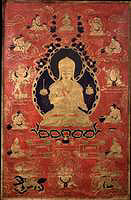
|
Lama Sakya Pandita (painting no. 42)
|

View Larger Image |
||||||||||||||
|
Thankga in the Sertang style (gold). Central figure: Sakya Pandita surrounded by lineage deities. Above: Dorjechang Vajradhara Upper left corner: Virupa Upper right corner: Dagmema (Vajranairatma) Below upper left corner: Damarupa Below upper right corner: Nagpopa Left: Hevajra Right: Vajrapani Below left: Kalamara (?) Below right: Avadhuti Below left: Lama Sekarchung Below right: Dromi Sakya Yeshes Left corner: Damchen Center: Kur gyi gonpo Right corner: Dudjom Karmo Lama Kunga Rinpoche 12/98 Sakya Pandita Kunga Gyaltsen Pal Zangpo (1182-1251): the Fifth Throne holder of Sakya. In a perfect pose similar to a buddha he performs the Dharma Teaching mudra (gesture) with the two hands placed at the heart while holding the stems of two utpala flowers blossoming to the sides supporting the sword of wisdom and the Prajnaparamita book. Fully attired in the robes of an ordained monk, having proven worthy, he wears the hat of a pandita. Within the ornate spheres of a nimbus and areola he sits above a variously coloured lotus blossom atop a Dharma Teaching throne. At the front a small table supports a black begging bowl, cup and gold water flask. At the top center the primordial buddha Vajradhara holds a vajra and bell crossed at the heart; wearing jewels and silk garments. At the right and descending is the female goddess Nairatmya holding upraised a curved knife in the right hand and a skullcup in the lap. The mahasiddha Kanhapada (Krishna) with the right hand in the mudra of blessing holds a skullcup in the left. The wrathful bodhisattva Vajrapani with one face and two hands holds aloft a vajra in the right and performs a wrathful gesture with the left; while in a standing posture. The pandita and mahasiddha Gayadhara touches the seat with the right hand and holds a book in the left. Descending at the left - the mahasiddha Virupa performs the Dharma Teaching mudra with the two hands at the heart. Mahasiddha Damarupa holds a damaru drum in the right hand and a skullcup in the left which rests on the upraised knee. The wrathful tutelary deity Hevajra with eight faces and sixteen hands, stands in a dancing posture surrounded by the flames of pristine awareness. Seton Kunrig with the right hand in the gesture of blessing holds a book in the left. Along the bottom are three wrathful protectors. At the center is Panjarnatha Mahakala, with one face and two hands holding a curved knife and skullcup to the heart; supporting a horizontal stick across the forearms. At the right is a form of Mahakali, Dumo Remati, with one face and two hands holding a spear in the right and a heart in the left, riding on a mule. To the left is Damchen Dorje Lekpa with one face and two hands holding a vajra in the right and a heart in the left, riding a snow lion. Hevajra Lineage: Vajradhara, Nairatmya, Virupa (9th century), Kanhapa, Damarupa, Avadhutipa, Gayadhara (994-1043), Drogmi Lotsawa (992-1072), Seton Kunrig (1025-1113), Shangton Chobar (1053-1136), Sachen Kunga Nyingpo (1092-1158), Sonam Tsemo (1142-1182), Trakpa Gyaltsen (1147-1216), Sakya Pandita (1182-1251), etc. The style of painting is called 'tsal thang.' On a vermilion, or similar, red background the figures are drawn, gold filled and lightly highlighted with various earth pigments. The names of the accompanying figures are written in barely legible black lettering beneath each. Jeff Watt 10-98
|
|||||||||||||||
Photographed Image Copyright © 1998 Shelley & Donald Rubin Foundation
|
|
| |
Next Image |